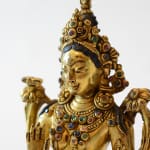Sino Tibetan figure of Tara, 1800 CE - 1900 CE
Gilt Bronze imbedded
height 15.2 cm
height 6 in
height 6 in
HB.065
Further images
White Tara is associated with longevity of life and healing. The figure originated in Hinduism where she was venerated as a Mother Goddess. By the sixth century A.D. she had...
White Tara is associated with longevity of life and healing. The figure originated in Hinduism where she was venerated as a Mother Goddess. By the sixth century A.D. she had been incorporated into Buddhism as a bodhisattva. Seated on a lotus base in the dhyanasana position, Tara holds the stem of a lotus blossom in both hands. The left hand is held in kartari mudra and the right in varada mudra. The head is crowned with a diadem, arranged in front of a high chignon decorated with a gold finial. The jewellery is elaborate and includes two circular earrings with leaf-shaped attachments, two strings of beads on the torso and another set along the top of the dhoti. A celestial scarf runs from the back of the lotus blossoms, around the arms and finishes in an elegant flourish on either side. The most charming feature of this piece is the bodhisattva's facial expression. The head is bent slightly to the viewer’s left and the eyes are downcast in a gesture of meditation.









